At long last, I have Dickey pants
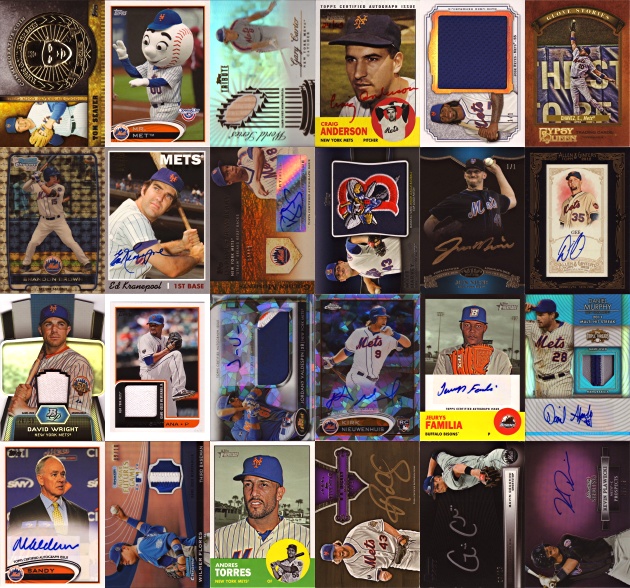
If you were looking for Mets pinstripe jersey cards this year, your only options for the bulk of the season were pieces from Gary Carter and Dwight Gooden. In fact, the last few years have been pretty barren for Mets pinstripes from active players, with just Carlos Beltran in 2011 and Johan Santana in 2010. No pieces from the pinstripe jerseys worn in 2010 (cream) or 2011 (ivory) have been released in cards. On that second point, nothing changed in 2012. The good news is that R.A. Dickey is here to save the hobby.
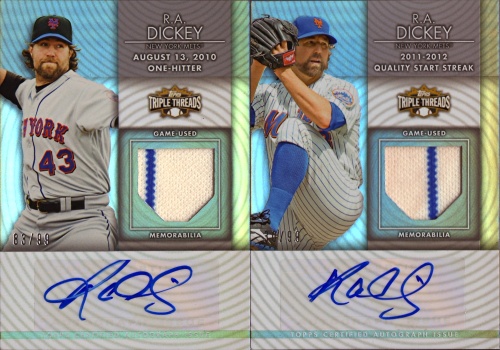
Not content to merely conquer mountains, books, movies, and that whole pitching thing, Dickey provided Topps with the material to produce the first pinstriped memorabilia card of an active Mets player since Santana in 2010. And this wasn’t just any old memorabilia, it was his pants from his second consecutive no-hitter, complete with distinctive dirt stains. On top of that, he also signed a couple thousand autograph stickers to be put on these and future cards. This is why everyone loves Dickey.
The Mets Have the Blues
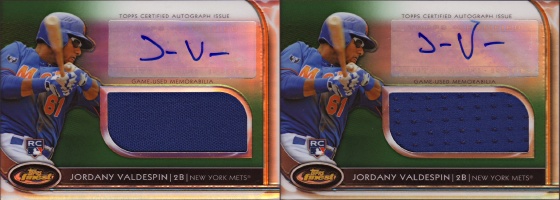
Perhaps the biggest news in Port St. Lucie this spring wasn’t related to the players but instead what they were wearing. The Mets had tried to get an alternate blue jersey added for 2012 but failed to get the design approved in time. As a consolation, MLB waived its usual requirement that all batting practice jerseys must be some sort of two-tone abomination and let the Mets use an all-blue version of the new style batting practice jersey (first seen at the 2011 All-Star event). Jordany Valdespin became the first Met to have one of these jerseys released one piece at a time in Topps Finest.
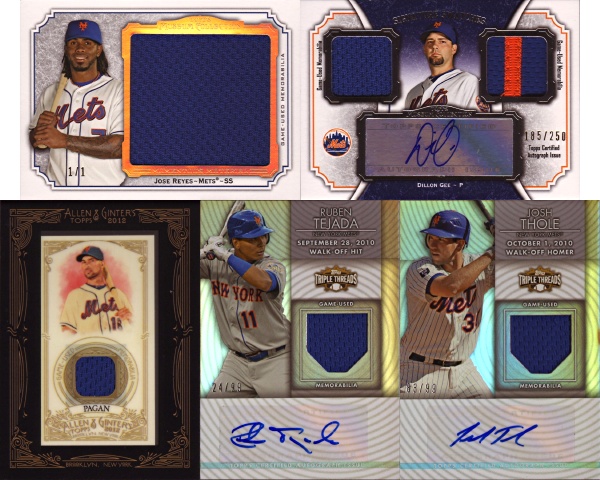
While Valdespin was alone with this year’s batting practice jersey, several other players had pieces of blue recessed mesh material from previous years’ batting practice jerseys or Los Mets jerseys released in 2012 products. Jose Reyes and Dillon Gee made their blue debuts in Topps Museum Collection, Angel Pagan debuted in Topps Allen & Ginter’s, and Ruben Tejada and Josh Thole rounded out the group in Topps Triple Threads.
And the Black Came Back
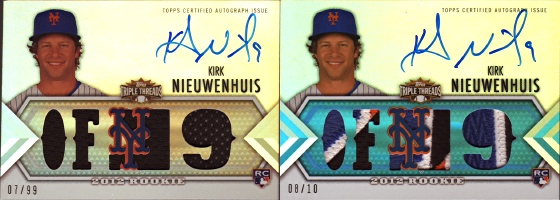
2012 was a landmark year in black removal for the Mets with the banishment of drop shadows, hybrid blue/black hats, and black socks and undershirts. One area they fell short in though was the elimination of the black alternate jersey. This jersey made one appearance in 2012 as part of a tribute to John Franco, whose Mets tenure, it should be pointed out, long predates the sad day when someone thought that black would good on the Mets. The black uniform just won’t die though (it has been confirmed to be in the mix for 2013) and Kirk Nieuwenhuis made his jersey debut with pieces from a black jersey which, if Topps is being honest, must be from the Franco game. I feel the urge to burn these cards, but I’m not ready to part with some of the dozens of Nieuwenhuis autograph cards I got this year. Tip for Kirk: learn to sign with your right hand. At this rate, Topps will burn you out before the Mets get a chance to.
And a Touch of Gray
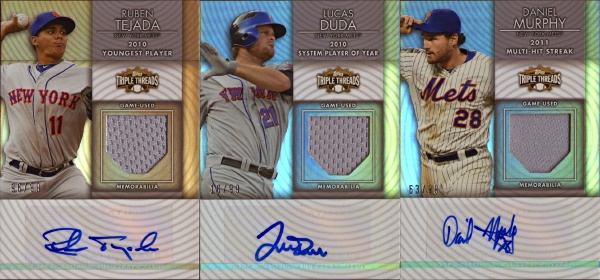
While this year’s gray road jerseys looked sharp, I doubt the pieces embedded in cards will be any more exciting than the usual boring gray swatches we’ve been seeing for years. Like the blue and black before them, three players appeared in Mets gray for the first time: Ruben Tejada, Lucas Duda, and Daniel Murphy. Duda’s was his first-ever game-used, Murphy’s was his first-ever jersey (likely pants though), and Tejada’s was, along with his blue jerseys, his first MLB-worn material (his previous game-used pieces are from a WBC jersey), though I only ever saw one card with a gray swatch (possible Topps mix-up?).
Patches
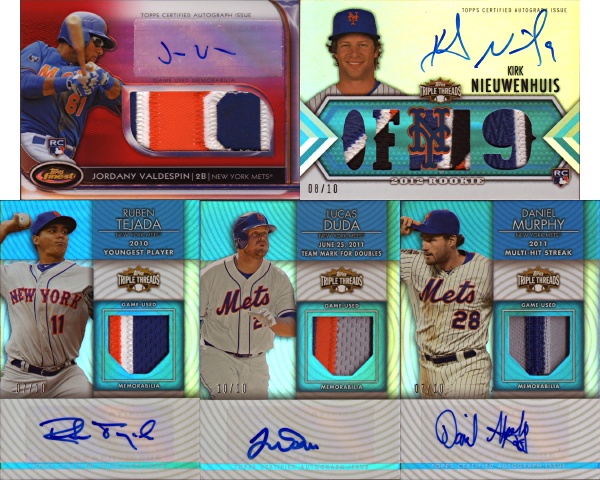
Rounding out this year’s game-used newcomers (nobody had their first bat cards this year) are Jordany Valdespin, Kirk Nieuwenhuis, Ruben Tejada, and Lucas Duda with their first Mets patch cards and Daniel Murphy with his first piping cards.
Back in April, I picked Ruben Tejada, R.A. Dickey, Lucas Duda, Chris Schwinden, Bobby Parnell, Mike Baxter, and Daniel Murphy to get some new memorabilia cards this year. Tejada (jersey/patch), Dickey (pants), Duda (jersey/patch), and Murphy (jersey/piping) all delivered, Parnell and Baxter could be in the mix for next year, and Schwinden is probably off the radar after his waiver claim whirlwind tour of AAA that ended back where it began. Kirk Nieuwenhuis and Jordany Valdespin exceeded expectations with jersey and patch cards released in their rookie years. I have to give Topps credit, they turned out material from these guys much faster than I thought they would.
Stars Past, Present, and Future
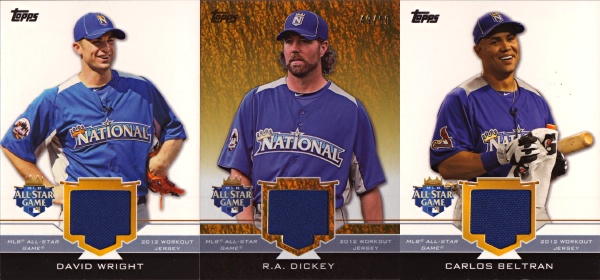
The All-Star event is always a good source of new memorabilia and this year’s didn’t disappoint. David Wright and R.A. Dickey were the only Mets on the NL All-Star team, with Beltran joining them as an ex-Met. For the second year in a row, no former or (as of yet) future Mets were on the AL All-Star team. Unlike last year, secondary colors were not mixed in with the primary color swatches (except in a couple of three-player cards), so we only got three blue jersey cards. And a few outstanding jumbo patches. With “few” meaning 6 of each player. Sadly, this put them out of my price range (the authentic jerseys cost far less and have all of the patches, though not event-worn). I miss the days of All-Star patch cards numbered to 100…
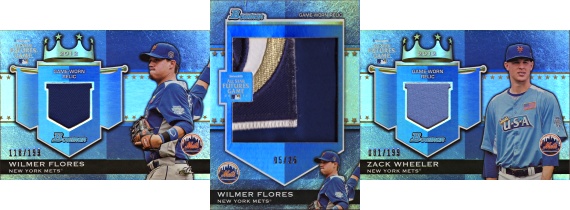
Over in Futures land, the Mets sent a pair of players to make their second appearance at the event. Wilmer Flores (2009 World Team) and Zack Wheeler (2010 USA Team) went back for a second time as their days in the minors wind down. Patch cards here were somewhat more plentiful, though Wheeler’s haven’t hit the secondary market in quantity yet (I’ve only seen two put up for sale out of the 35 total made). As with the All-Star jersey cards, secondary colors have yet to appear.
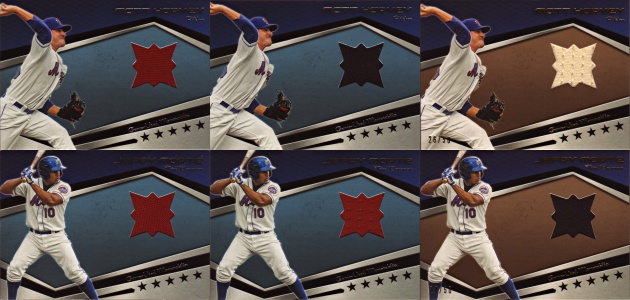
Well, for the 2012 Futures Game at least. 2012 Topps Pro Debut featured cards with primary and secondary color swatches from 2011 Futures Game jerseys (Matt Harvey and Jefry Marte). A few patch cards also appeared in a couple of products. 2011 All-Star jersey patch cards from David Wright, Jose Reyes, and Carlos Beltran were released in 2012 Topps Series 1 and 2012 Topps Triple Threads, though all were numbered to 9 or 1.
Elsewhere in MLB
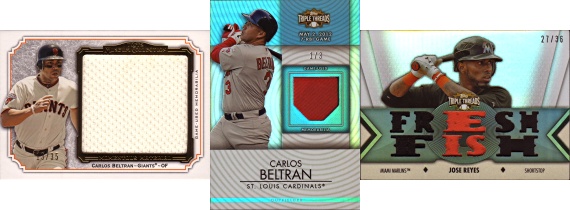
Carlos Beltran and Jose Reyes suited up with new teams this year and both had new memorabilia from their post-Mets days released in 2012. Beltran started the year with jumbo jersey cards from a Giants uniform in Topps Museum Collection and finished it with jersey and patch pieces from a Cardinals jersey in Topps Triple Threads. Reyes’s Marlins spring training jersey made its way into Topps Triple Threads with black, black mesh, and orange mesh jersey pieces and a few patch cards.
Oh, and there was a massive scandal involving the sale of fake game-used memorabilia to all three major card manufacturers. The manufacturers have been silent on this issue.
Heavy Metal
Let’s face it, game-used material in baseball cards is getting boring. Other sports have things like lacing or material other than fabric and wood, but the best MLB can do is patches, tags, bat knobs, and bat name plates. It doesn’t help that most of the jerseys in MLB are white, gray, or black; say what you will about Oakland’s yellow jerseys, but they’re certainly not boring.
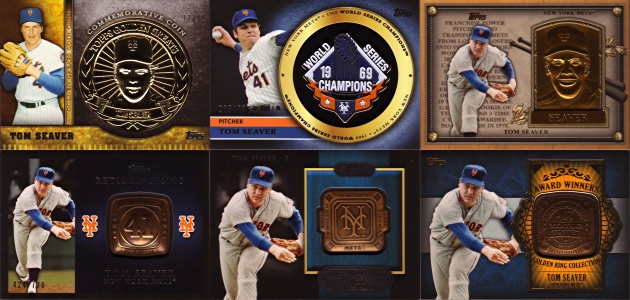
With game-used material failing to excite the masses, Topps has turned to manufactured material to add some variety to its relic offerings. Past offerings have brought us patches, hat logos, and poorly-received glove leather, but Topps went in a different direction in 2012. This year, Topps introduced four types of metal manufactured material cards, all in its mainline product. The pins and rings are missing the parts that would make them pins and rings (pointy bits and, um, rings, respectively), but the coins are complete double-sided medallions. The Hall of Fame plaques turned out to be some of the best metal cards produced, even though they don’t look much like the actual plaques. Tom Seaver is the Mets’ lone representative in most of these sets, with a Darryl Strawberry pin card being the only exception.
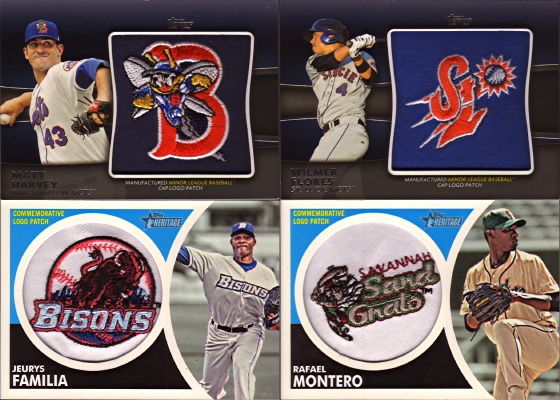
Topps brought logo patches to the minors in this year’s Pro Debut and Heritage Minor League. The Mets had representatives from their four highest-level minor league teams, though the two from Heritage Minor League came as redemptions that didn’t get sent out until late December. I guess it’s better than that 2011 Bowman Platinum Matt Harvey Autograph I’m still waiting for…

Speaking of autographs, Panini isn’t going to be left out of this. 2012 Panini Signature included three different manufactured material autographs from three Mets. It’s not quite Sweet Spot, but it’s a promising start.
Partying Like It’s 1969
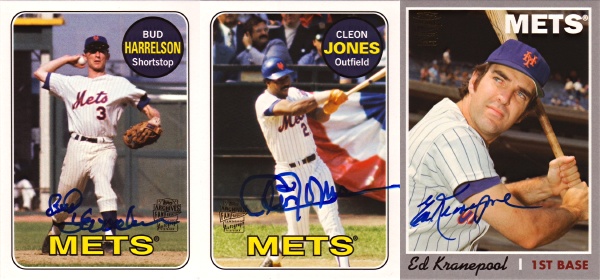
The return of Topps Archives was one of the high points of 2012 and it came with an outstanding autograph set. In fact, a set of retired player on-card autographs like this hasn’t been seen since Archives last appeared in 2005. While the 2012 product can’t rival 2005’s list of Mets, it still featured seven Mets and several more former Mets shown in other uniforms (most notably Jose Oquendo on nine different cards, one for each position he played in a single game). Among those are 1969 Mets Bud Harrelson, Cleon Jones, and Ed Kranepool, back after an absence of several years. Kranepool later appeared on more on-card autograph cards in Topps Tier One and sticker autograph cards in Topps Update.
Justin Turner Auto Time
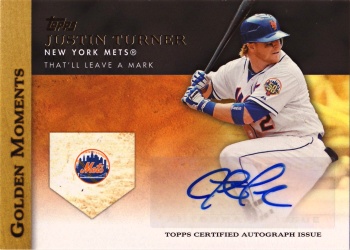
Also appearing on a sticker autograph in Topps Update is Justin Turner. Turner, best known for being the guy who pies people after walkoff wins, received his first game-used jersey card at the very end of 2011 in Bowman Sterling. He follows that up in 2012 with his first certified autograph card.
Inked
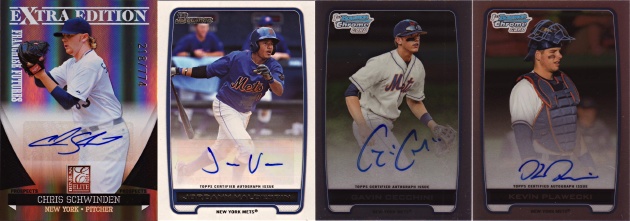
Several other Mets had certified autograph cards for the first time in 2012. Chris Schwinden started things off in 2011 Panini Donruss Elite Extra Edition alongside several 2011 draft picks. Jordany Valdespin became the first Met with a 2012 Bowman autograph with a sticker autograph in Bowman retail packs (sadly, no Mets were featured in the chrome on-card autographs in Bowman and Bowman Chrome). 2012 draft picks Gavin Cecchini and Kevin Plawecki rounded out the meager Mets offerings in Bowman with chrome autographs in Bowman Draft Picks & Prospects and Bowman Sterling.
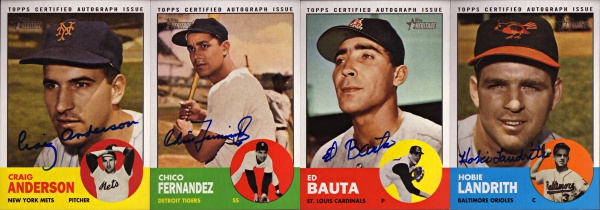
Topps Heritage, as usual, added autographs from several Mets from the 1960s: Craig Anderson, Chico Fernandez, Ed Bauta, and Hobie Landrith.
Topps Breaks the Ice with a New Wave of Refractors
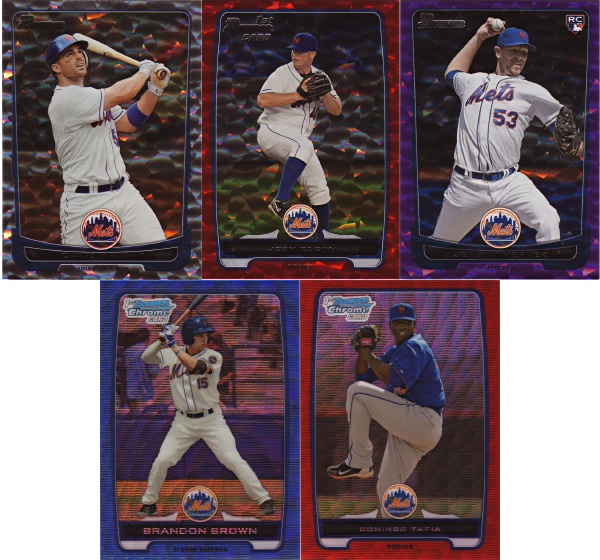
I am so sorry for that. With such a limited selection of parallels between the various colored borders, colored border refractors, atomic refractors, xfractors, and superfractors, Topps was in dire need of something new. Enter the ice parallels (base Bowman) and wave refractors (Bowman Chrome), both with serial numbered color variants of their own. Topps leads the way in making the same card as many times as possible.
Bonus!
Everybody loves free packs, so I was glad to see that all three major manufacturers found ways to deliver added value through extra packs (though only two of them featured baseball cards).
Upper Deck had the only true “free” offering with its National Hockey Card Day packs, now available south of the (Canadian) border. It seems like not many people knew about it in the US, because I was the first person to ask about it in one shop and the second shop gave me four packs because of the amount they had left at the end of the day. With a 15-card set, 5 5-card packs should have been enough to get close to completing the set. If not for another colossal Upper Deck collation screw-up. The 5 packs only had 8 different cards, with the same two cards on the top in each pack. Upper Deck has acknowledged the problem and claims that it will be corrected when they bring the promotion back in 2013, which may happen before the 2012-2013 NHL season starts.
Panini continues to endear itself to collectors through frequent promotional giveaways, though none of them applied to baseball until their Black Friday promotion, which featured players from all four sports. With a free pack of two Black Friday cards for every $10 spent on boxes of Panini products, it didn’t take much to get quite a haul. The packs featured the biggest rookies and stars in each sport and mixed in cracked ice parallels, autographs, and memorabilia cards. It was hard not to like what came out of these packs, even if you don’t follow the other sports. I traded away my biggest pull, an Anthony Davis serial numbered rookie card, for a couple of Mike Trout rookies; my packs had no baseball cards but were loaded with basketball, so I traded with a basketball collector who opened his packs in the shop at the same time. I can’t wait to see what Panini has in store for 2013, they made collecting fun again in 2012.
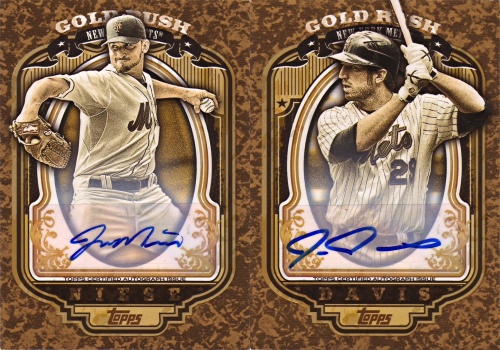
And then there’s Topps. Topps had various promotions in 2012, but no real giveaways; everything was an exchange, either in-store card exchanges or wrapper redemptions. Four products featured mail-in wrapper redemptions: Topps Series 1, Topps Series 2, Bowman, and Bowman Chrome. For the Topps line, the redemptions were for packs of Gold Rush cards, which also included autographed (sticker) versions numbered to 100. For Bowman, the redemptions were for packs of blue wave refractors, with autographed versions numbered to 50 and red wave parallels numbered to 50. I skipped Topps Series 1 but sent in for the others, with mixed results. The Topps Series 2 Gold Rush packs were a total bust, with only 6 different cards between two 5-card packs (the duplicates were even in the same order, indicating a fixed pack-out sequence and an offset of just one position between the two packs). Bowman was the big winner, with four boxes bringing back four 5-card packs loaded with prospects, with one red wave refractor and one autograph. Bowman Chrome had half the return with four boxes only bringing back two packs with a low value autograph being the only big card. Overall, that’s a pretty good bonus, but I could do without the Gold Rush packs (should have just sold the packs…).
Farewells
Now the hard part. Several Mets have turned in their pinstripes in 2012, though I expect it will take a few months for the cards to catch up.
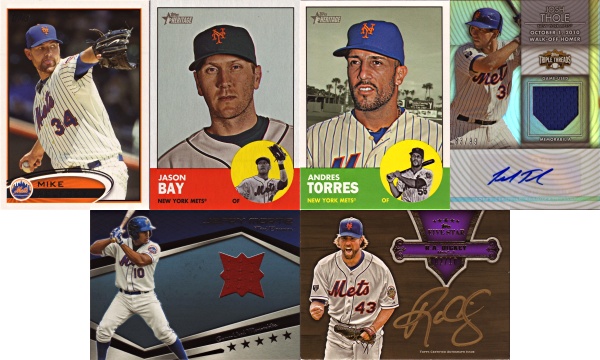
After suffering a season-ending injury at the start of the 2012 season, Mike Pelfrey was non-tendered and signed with the Twins in the offseason. Pelfrey hasn’t been relevant in cards for several years, but he was still a reliable starter and will be missed.
The same can’t be said for Jason Bay, who was released on a largely deferred buyout after his third disappointing season with the Mets. He didn’t have any premium cards in 2012, but he was still inexplicably featured as a short print in Topps Heritage and one of only three Mets in the Topps Opening Day set. He signed with the Mariners and we wish him the best.
With Bay gone, the Mets had an opening for a right-handed outfielder. Their solution? Trade Jefry Marte for Collin Cowgill. Marte last played at the AA level as a third baseman, so he was expendable. He signed a ball for me at a Binghamton Mets game, so I’m a little bit sad to see him go.
The Mets have been sorely lacking in offensive production at the catcher position, so changes needed to be made. A late-season deal sent Rule 5 pickup Pedro Beato to the Red Sox for Kelly Shoppach. Shoppach himself was then let go in free agency. Mike Nickeas was lost and reacquired as a minor league free agent before being traded with Josh Thole to the Blue Jays for catchers John Buck and Travis d’Arnaud (among others). Thole outperformed expectations with the Mets but lost all of his power after a collision at the plate left him with a concussion. Mike Nickeas didn’t fare any better at the major league level but excelled in AAA. You hate to see guys like this leave, but changes needed to be made.
Oh, right, the centerpiece of the above trade was none other than Mets ace and Cy Young knuckleballer R.A. Dickey. Dickey started 2012 a fan favorite and ended it a folk hero, outshining Tim Tebow and Jeremy Lin. Unfortunately, his stellar performance and reasonable contract made him a prime trade chip, especially when the available pitching dried up and the Blue Jays needed an ace to have a chance at the suddenly wide-open AL East. With the best catching prospect in baseball and an overpaid Marlins castoff among their ranks, they had what it took to make a Dickey deal inevitable. And they also threw in a top pitching prospect and a young promising outfielder. Losing Dickey is tough, but you can’t not make that deal. Or at least that’s what I keep telling myself. I won’t be upset if Topps takes a few months to update Dickey’s team affiliation.
A few other faces from 2012 won’t be back in 2013, though it might take a while for the offseason to shake things out. Andres Torres has moved on and Kelly Shoppach probably won’t be back. Update: Looks like I left Omar Quintanilla out, but he’s now back with the Mets so that one’s moot. I also forgot about Miguel Batista, but we all forgot about Miguel Batista (or at least we try to).
Hails
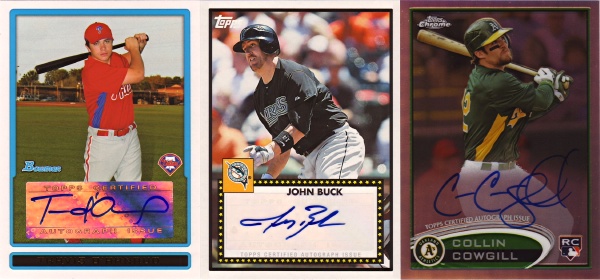
After losing 88 games, the Mets needed to make some serious changes. As of the end of 2012 though, they’re really no better off going into 2013 than they were a year earlier. Beyond that though, the farm system is looking better, so that’s something. It’s going to be a long 2013.
Travis d’Arnaud was the centerpiece of the Toronto side of the Dickey trade, but his card history is nothing special, just a jersey card in 2011 Topps Heritage Minor League Edition and some autographs. He was selected to appear in the 2012 Futures Game but did not attend due to injury, so there’s no memorabilia from that.
Noah Syndergaard adds yet another interesting pitcher to a single A level that is loaded with pitching. Even though he’s still a few years out, he already has a couple of autograph cards.
John Buck was the big haul in the Dickey trade, from a card perspective at least. Despite not having a superstar pedigree, he hits on pretty much every type of memorabilia: autograph, Futures Game (2002 USA Team), All-Star (2010 AL), colored jersey (blue Royals), pinstripe jersey (Astros), patch (Astros), bat, fielding glove, catcher’s equipment, etc. Interestingly, much of his memorabilia is from the Astros even though he never appeared in an official Astros game (spring training?). At a total value of 7.25 GU, Buck rates as the best acquisition since Gary Sheffield, who came in at more than double Buck’s mark.
Needing a big righty bat in the outfield, the Mets dealt surplus third base prospect Jefry Marte to Oakland for outfielder Collin Cowgill. Don’t everyone get excited at once. It’s an upgrade, but the outfield looked terrible beforehand. Sadly, I pulled one of his autographs from 2012 Topps Chrome and sold it on eBay for $0.99. Crap. I really need to hang on to more of these worthless autographs.
In Memorium
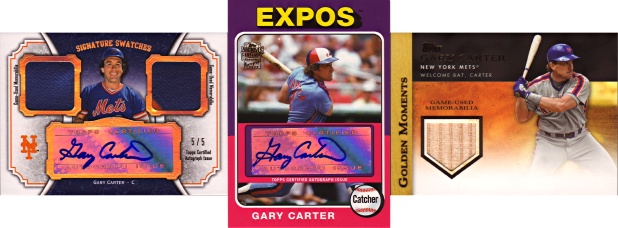
Several former Mets passed on in 2012, but one has been a major fixture in the hobby for many years. As I covered previously, Gary Carter has been one of the most prominent Mets in game-used and autograph cards since 1999. He will undoubtedly be remembered in cards for many years to come.
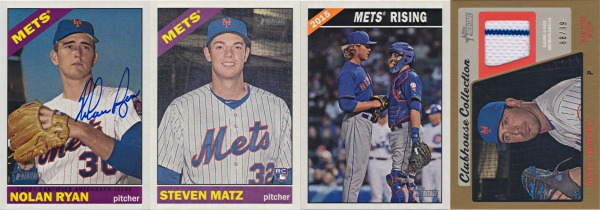 Heritage and I have a strange relationship. When the debut edition became the hottest product of 2001, I chose to sell while it was hot rather than chase the set. I skipped the next decade of Heritage and have bought some each of the four years since, never quite finishing any sets and always falling short of getting my money’s worth. Still, I keep coming back to be somewhat disappointed the next year…
Heritage and I have a strange relationship. When the debut edition became the hottest product of 2001, I chose to sell while it was hot rather than chase the set. I skipped the next decade of Heritage and have bought some each of the four years since, never quite finishing any sets and always falling short of getting my money’s worth. Still, I keep coming back to be somewhat disappointed the next year…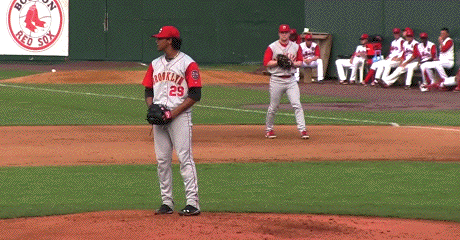
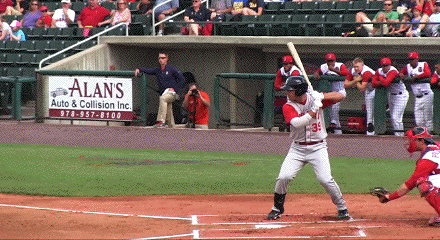
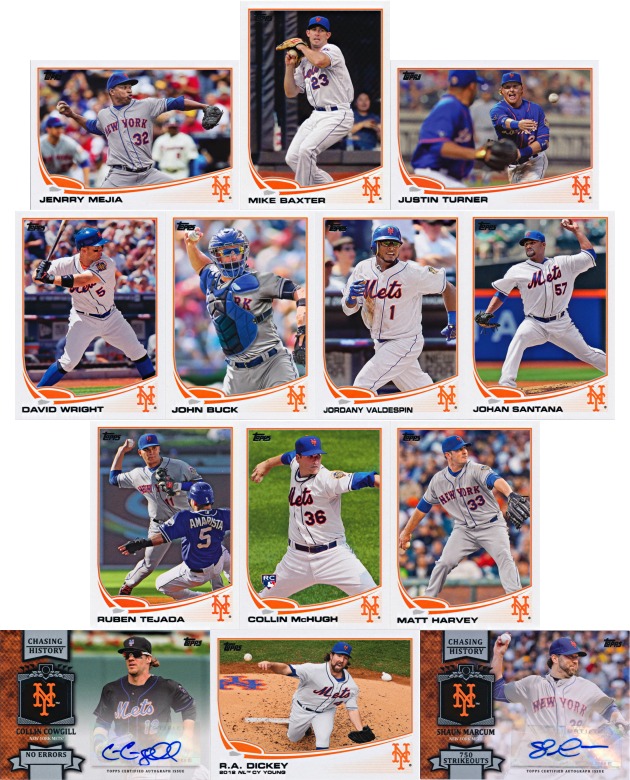
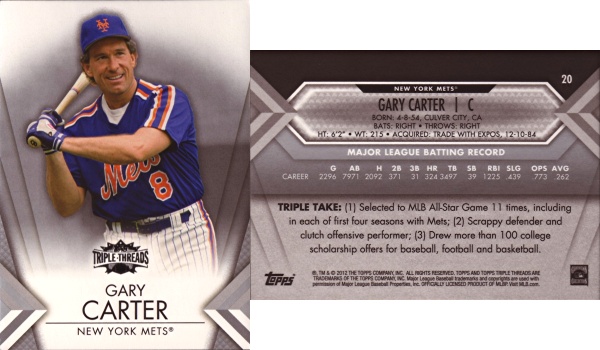
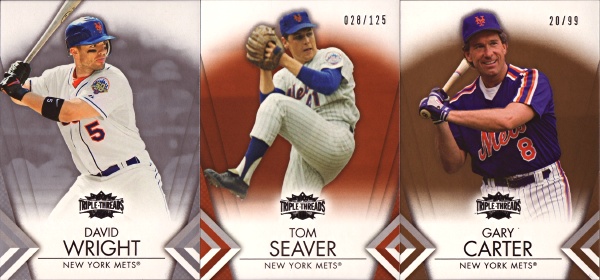

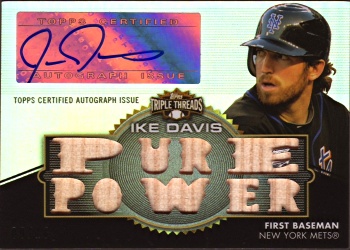
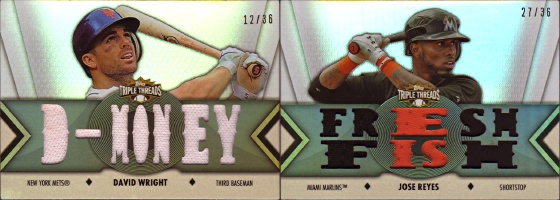

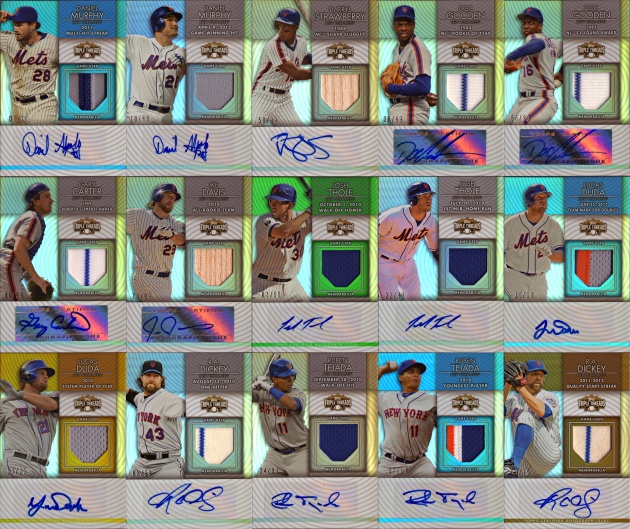
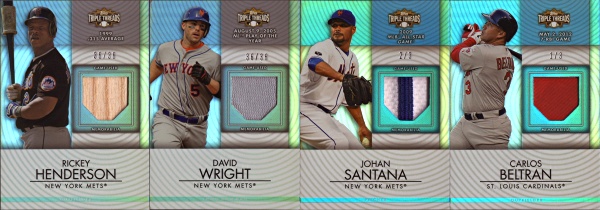























Recent Comments